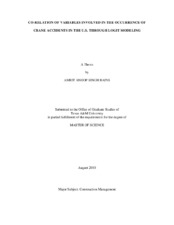| dc.description.abstract | One of the primary reasons of the escalating rates of injuries and fatalities in the construction industry is the ever so complex, dynamic and continually changing nature of construction work. Use of cranes has become imperative to overcome technical challenges, which has lead to escalation of danger on a construction site. Data from OSHA show that crane accidents have increased rapidly from 2000 to 2004. By analyzing the characteristics of all the crane accident inspections, we can better understand the significance of the many variables involved in a crane accident.
For this research, data were collected from the U.S. Department of Labor website via the OSHA database. The data encompass crane accident inspections for all the states. The data were divided into categories with respect to accident types, construction operations, degree of accident, fault, contributing factors, crane types, victim’s occupation, organs affected and load. Descriptive analysis was performed to compliment the previous studies, the only difference being that both fatal and non-fatal accidents have been considered.
Multinomial regression has been applied to derive probability models and correlation between different accident types and the factors involved for each crane accident type. A log likelihood test as well as chi-square test was performed to validate the models. The results show that electrocution, crane tip over and crushed during assembly/disassembly have more probability of occurrence than other accident types. Load is not a significant factor for the crane accidents, and manual fault is more probable a cause for crane accident than is technical fault. Construction operations identified in the research were found to be significant for all the crane accident types. Mobile crawler crane, mobile truck crane and tower crane were found to be more susceptible. These probability models are limited as far as the inculcation of unforeseen variables in construction accidents are concerned. In fact, these models utilize the past to portray the future, and therefore significant change in the variables involved is required to be added to attain correct and expedient results. | en |


